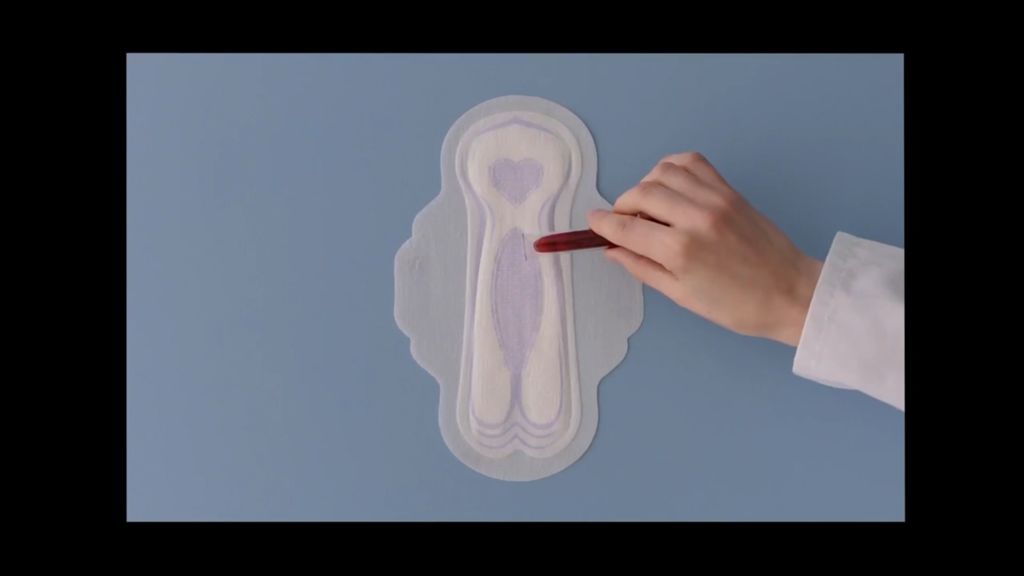True blood
Broadcast ads for period products were banned until 1972, and it wasn’t until 2017 that a commercial depicting red blood, rather than blue liquid, was aired on TV. AMV BBDO Chief Creative Officers, Nadja Lossgott and Nick Hulley, along with Margaux Revol, the agency's Strategy Partner, talked to shots about presenting gynaecological reality with their taboo-smashing Essity campaigns, Blood Normal and Wombstories.
Credits
powered by
- Agency AMV BBDO/London
- Production Company Somesuch
- Director Daniel Wolfe | (Director)
-
-
Unlock full credits and more with a Source + shots membership.
Credits
powered by
- Agency AMV BBDO/London
- Production Company Somesuch
- Director Daniel Wolfe | (Director)
- Producer Edwina Dennison
- Executive Creative Director Alex Grieve
- Executive Creative Director Adrian Rossi
- Creative Partner Toby Allen
- Creative Partner Jim Hilson
- Copywriter Nicholas Hulley
- Art Director Nadja Lossgott
- Art Producer Kirstie Johnstone
- Joint Chief Strategy Officer Bridget Angear
- Planner Margaux Revol
- Project Manager Leonie Chaudhry
- Music Felt Music
- Audio Post Sam Ashwell
- Editor Tom Lindsay
- Post Production The Mill/London
- Post Production Framestore/London
- Executive Producer Lou Hake
- Producer Tim Nash
- Account Exec Sarah Douglas
- Producer Sally Llewellyn
- DP Monika Lenczewska
- Planners Rebecca Fleming

Credits
powered by
- Agency AMV BBDO/London
- Production Company Somesuch
- Director Daniel Wolfe | (Director)
- Producer Edwina Dennison
- Executive Creative Director Alex Grieve
- Executive Creative Director Adrian Rossi
- Creative Partner Toby Allen
- Creative Partner Jim Hilson
- Copywriter Nicholas Hulley
- Art Director Nadja Lossgott
- Art Producer Kirstie Johnstone
- Joint Chief Strategy Officer Bridget Angear
- Planner Margaux Revol
- Project Manager Leonie Chaudhry
- Music Felt Music
- Audio Post Sam Ashwell
- Editor Tom Lindsay
- Post Production The Mill/London
- Post Production Framestore/London
- Executive Producer Lou Hake
- Producer Tim Nash
- Account Exec Sarah Douglas
- Producer Sally Llewellyn
- DP Monika Lenczewska
- Planners Rebecca Fleming
Let’s be frank, those working in advertising are often afforded little more admiration from the outside world, than estate agents and career politicians. And the problem is a perceived lack of authenticity, that image of snake oil salesmen misleading us with misrepresentations, if not downright lies.
Can there be anything more disingenuous than the portrayal of a menstruating woman as a roller skater in white jeans sporting an inane grin, probably overjoyed at the fact that she issues jolly blue blood from her womb? Not the painfully wrought blobby red stuff of reality.
But such accidental lies were a product of the culture of the time, not the fault of the creatives. Those of us in the industry, know that actually, it is populated by some of the nicest people on the planet, and a meeting with AMV BBDO's Executive Creative Directors, Nadja Lossgott and Nick Hulley only confirms that.
When the Blood Normal campaign splashed onto our screens in 2017, it shone out as a beacon of authenticity. Sure, it was a win-win, it garnered a stash of awards and made Essity products, Bodyform/Libresse, the fastest growing femcare brand in the world, but it was also the result of a genuine desire by the team to smash a taboo and set free those nine out of 10 women who attempt to hide their periods each month.

AMV BBDO's dream team Nick Hulley and Nadja Lossgott.
When asked about how the idea to get real with blood came about, it seems, as with all cultural shifts, that the time was right. “There was a lot of chatter, you could feel it,” says Hulley, “ads were talking about ‘self-confidence’ but everybody who was working in the category knew it was riddled with cliché and nonsense euphemisms.”
We think there's a real duty in making the world a place where women can have a positive, healthy relationship with their bodies.
Lossgott says they suddenly realised, “holy shit, one of the main things that perpetuates the idea that periods are disgusting is the blue liquid. The idea was to create a normality, almost an explosion of normality around it. There’s a great Gloria Steinem quote – ‘the first problem for all of us, men and women, is not to learn but to unlearn’.” The duo’s mission was to help society unlearn that having a period is somehow “abnormal or gross”. A feeling that sadly many women grow up with.
Hulley states that: “It seemed to us that the only blood that leaves the body naturally was the blood that is vilified. You can show blood coming out of sports injuries or from gunshot wounds in Hollywood movies but that natural blood was the one we were not allowed to show.”
You get feedback that the embroidered underwear is an absolute no-no. And you think, 'this is literally embroidered underwear, how can that be bad?'.
Margaux Revol describes the credibility of the mission that drove the campaign: “there’s a reality about periods and women’s bodies that is inextricably linked to the body politic and women’s reproductive rights. Often the silence and lack of open representations perpetuate the shame women and girls feel about their bodies. It has many ramifications way beyond confidence, from mental health to physical health issues (missing out on routine tests, under-reporting of issues, lack of medical research, etc.). We think there’s a real duty in making the world a place where women can have a positive, healthy relationship with their bodies.”

The team had to fight to show period-themed embroidered underwear in Blood Normal.
Despite the fact that the time seemed right, the team had a battle on their hands, but it wasn’t in persuading the brand to be bold. “No,” says Hulley, “we had a brilliantly tight team of Martina and Tanja and Margaux on the strategy side, we just had a battle with pretty much everyone else.”
Lossgott chimes in, “It was the media partners and broadcasting and the people that hold the key to those doors, those are the people that we were dealing with."
So, did the battling ever lead to doubts? “Well you do start questioning yourself, which was crazy,” admits Lossgott. “Then you think, it’s 2017, everyone’s going to be totally fine with this, but then you get feedback that the embroidered underwear is an absolute no-no. And you think, this is literally embroidered underwear, how can that be bad?”
It had a huge ripple effect in culture
“We had to fight back inch by inch,” she goes on, “it brought us closer as a team because all around you, outside of the bubble, people are questioning what you’re doing and thinking it’s gross or crazy.”
Another initial no-no was the couple kissing, the implication being that they were going to have sex while she was on her period. “Yet you read features in men’s magazines about the best places to have sex,” says Hulley, “or are totally okay with showing sexualised woman in their underwear,” adds Lossgott, “that was the hypocrisy and inauthenticity we wanted to call out."

Normal blood in Blood Normal.
And the breaking of that taboo changed the category completely, making the use of blue liquid soooo last year. “It had a huge ripple effect in culture,” says Lossgott, “which I think we’re super proud of.”
There were those, however, who refused to see things in a different way. The taboo is still a strong one. Two years after Blood Normal ad, an Australian TVC for Libra showing menstrual blood received hundreds of complaints. One was that the attempt to normalise periods was “unnecessary – periods are private matters of personal hygiene.” “Showing girls bleeding is wrong at any time of the day,” said another.
Lossgott points out that Blood Normal was the most complained about ad in Australian history. But what was interesting was that the country’s version of Advertising Standards dismissed the complaints.
Credits
powered by
- Agency AMV BBDO/London
- Production Company Chelsea
- Director Nisha Ganatra
-
-
Unlock full credits and more with a Source + shots membership.
Credits
powered by
- Agency AMV BBDO/London
- Production Company Chelsea
- Director Nisha Ganatra
- Creative Director Toby Allen
- Creative Director Jim Hilson
- Executive Creative Director Nicholas Hulley
- Executive Producer Nadja Lossgott
- Producer Edwina Dennison
- Production Service PSN Production Service Network
- Executive Producer Pat McGoldrick
- Executive Producer Lisa Mehling
- Producer Shanah Blevins
- Editing Company Trim
- Editor Elise Butt
- Sound Design 750mph
- Sound Engineer Sam Ashwell
- Post Production Company Framestore/London
- Creative Director Animation Sharon Lock
- Colorist Simon Bourne
- DP Natasha Braier
- Flame Artist Tim Greenwood
- Chief Creative Officer Alex Grieve

Credits
powered by
- Agency AMV BBDO/London
- Production Company Chelsea
- Director Nisha Ganatra
- Creative Director Toby Allen
- Creative Director Jim Hilson
- Executive Creative Director Nicholas Hulley
- Executive Producer Nadja Lossgott
- Producer Edwina Dennison
- Production Service PSN Production Service Network
- Executive Producer Pat McGoldrick
- Executive Producer Lisa Mehling
- Producer Shanah Blevins
- Editing Company Trim
- Editor Elise Butt
- Sound Design 750mph
- Sound Engineer Sam Ashwell
- Post Production Company Framestore/London
- Creative Director Animation Sharon Lock
- Colorist Simon Bourne
- DP Natasha Braier
- Flame Artist Tim Greenwood
- Chief Creative Officer Alex Grieve
The duo's next groundbreaking campaign for Bodyform, Wombstories, triumphantly conveyed the great complexity, the range of experiences that wombs bring about. So how did they hit upon the idea of anthropomorphising the womb?
We didn’t want to make a clichéd, femvertising ad.
“The brief was for a more holistic approach that touched upon different experiences,” recalls Lossgott, “we looked at all the advertising around it, which was in the female empowerment category, and thought we didn’t want to make a clichéd, femvertising ad.” What struck them when gathering genuine experiences was the variety “sometimes having a womb is freaking awful, sometimes you’re super happy about it, sometimes you’re completely ambivalent towards it.”

From hot flushes, to burning pain, Wombstories visualised women's real experiences.
They realised the womb was the unifying principle that pulled all these ideas about gynaecological life together “we were trying to figure out what is the ‘housing’ for all these stories – then we realised the one commonality was the uterus,” says Lossgott.
The next aspect was the intensity of the emotional, as well as the biological aspect of having a womb. Hulley explains how “from the language of the relationship a woman has with her uterus was born the personification of it and then we started pondering the metaphorical angle."
Credits
powered by
- Agency AMV BBDO/London
-
-
-
-
Unlock full credits and more with a Source + shots membership.
Credits
powered by
- Agency AMV BBDO/London
- Chief Creative Officer Alex Grieve
- Chief Creative Officer Nadja Lossgott
- Chief Creative Officer Nicholas Hulley
- Creative Director Toby Allen
- Creative Director Jim Hilson
- Creative Director Nadja Lossgott
- Creative Director Nicholas Hulley
- Copywriter Augustine Cerf
- Art Director Lauren Peters
- Creative Producer Rosie Stipic

Credits
powered by
- Agency AMV BBDO/London
- Chief Creative Officer Alex Grieve
- Chief Creative Officer Nadja Lossgott
- Chief Creative Officer Nicholas Hulley
- Creative Director Toby Allen
- Creative Director Jim Hilson
- Creative Director Nadja Lossgott
- Creative Director Nicholas Hulley
- Copywriter Augustine Cerf
- Art Director Lauren Peters
- Creative Producer Rosie Stipic
Working with a researcher, they set about looking for data that didn’t at that time exist, Lossgott says, “we asked women all over the world metaphorical questions. So, if your uterus was a place, or person describe it to us, what would it be like, what would its soundtrack be….”
They came up with the concept of a “womb dweller” – various uterine personalities. For example, a late period was depicted as a lazy womb that was asleep and suddenly wakes up and starts the period.
“There’s a beauty and storytelling honesty involved in something like that,” says Lossgott, “We didn’t want some pseudo nonsense with two or three different experiences. We wanted to unlock all these stories with proper research.”
The success of the Bodyform campaigns paved the way and encouraged other brands to follow suit.
They realised that discussing painful or intense experiences using metaphors was freeing.
When the film came out it triggered more openness leading to “an outpouring on social media that created even more data for us to then put back into the culture,” recalls Hulley. It was also important clinically in that it enabled an alternative way to describe pain beyond the one to ten scale. “Because the biology doesn’t have the words to describe the emotional experience – there is almost more truth in the metaphor.”

A uterine entity from Wombstories.
The next iteration in the Wombstories story was Pain Stories, which launched in 2021 with the Pain Dictionary, which enabled a more honest, almost accurate description of the pain of conditions, such as endometriosis, drawn from descriptions by actual sufferers.
To describe your pain as “like as a stab or having a bowling ball crashing into you,” and have these descriptions brought to life by artists enabled a more accurate representation of a condition than that the usual scale of one to ten. The project was lauded by the medical establishment as a diagnostic tool.
So, though the success of the Bodyform campaigns paved the way and encouraged other brands to follow suit, other attempts were not so deftly handled. Occasionally the quest for authentic voices can be so desperate as to come across as disingenuous.
You can’t ask women to live fearlessly if you’re not willing to do it yourself as a brand.
In 2020 Tampax launched a series of infomercials starring Amy Schumer interviewing people in a mall about tampon insertion. Though nobel in intent it had an awkward tone, and seemed scripted rather than genuine. “yes, we have strong opinions on that one” laughs Lossgott, but respectfully they don’t expand on their opinions.
Hulley points out though that the thing to celebrate is that Tampax made the films in the first place, “it’s a better world where you can make the mistake that they made, even if it missed attaining full interview authenticity.”
Credits
powered by
- Agency Publicis/New York
- Production Company Hungry Man
- Director Kathy Fusco
-
-
Unlock full credits and more with a Source + shots membership.
Credits
powered by
- Agency Publicis/New York
- Production Company Hungry Man
- Director Kathy Fusco
- Talent Amy Schumer

Credits
powered by
- Agency Publicis/New York
- Production Company Hungry Man
- Director Kathy Fusco
- Talent Amy Schumer
So, as in greenwashing, where companies attempt to jump on the eco bandwagon, have they noticed a kind of ‘red washing’ where femcare brands feel they must follow suit and strive, but fail, to convey a genuine message?
Lossgott comments, “I think that if you’re inauthentic and miss the mark, people are just going to feel advertised to and they’re going to switch off. The biggest turning point for us on our journey with Bodyform/Libresse was to take the ‘live fearless’ mantra [a brand platform launched in 2013] seriously as a company. You can’t ask women to live fearlessly if you’re not willing to do it yourself as a brand.”
Authenticity isn’t a genre, a style, or a visual look.
Revol adds: “what is critical is to always make sure you’re leaving your audience feeling understood. If what you’re showing or saying is at the expense of empathy, you’re just doing shock tactics. When we launched Blood Normal, Viva la Vulva or Wombstories, we knew from global listening that the campaigns resonated with the vast majority of women – so it was worth pushing for.”
She has an interesting view on how brands should strive for genuine messaging, “Authenticity isn’t a genre, a style, or a visual look. That’s when it tends to go wrong, and you end up putting words in people’s mouths or forcing new stereotypes – even if woke ones.” The aim should be, she goes on is to show you have “done your due diligence in listening to people and finding the things that speak more to their real lives and what’s relevant to them. Which doesn’t feel like such a bad thing to reconnect with in most categories.”

)


















